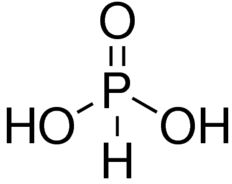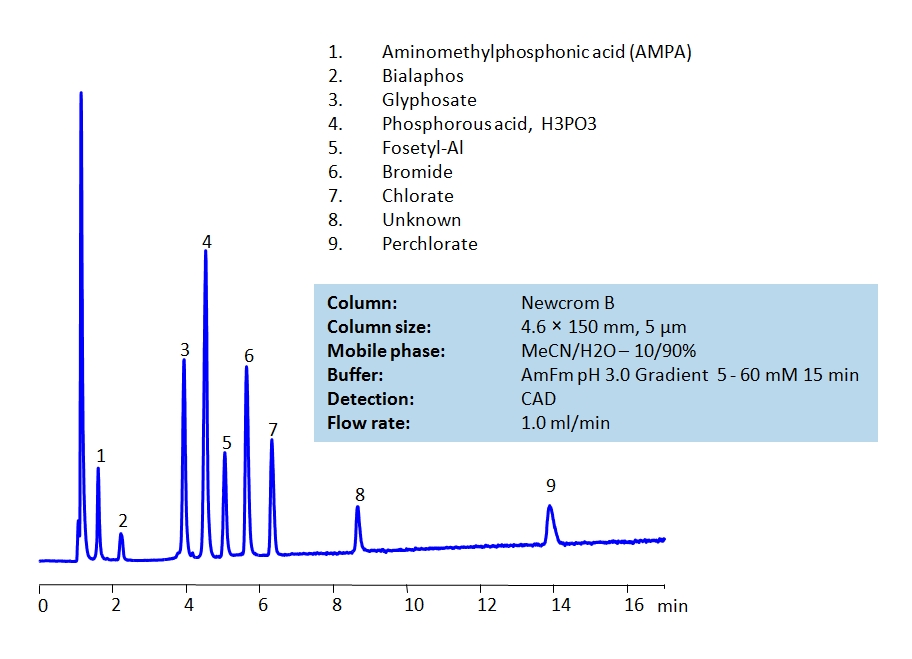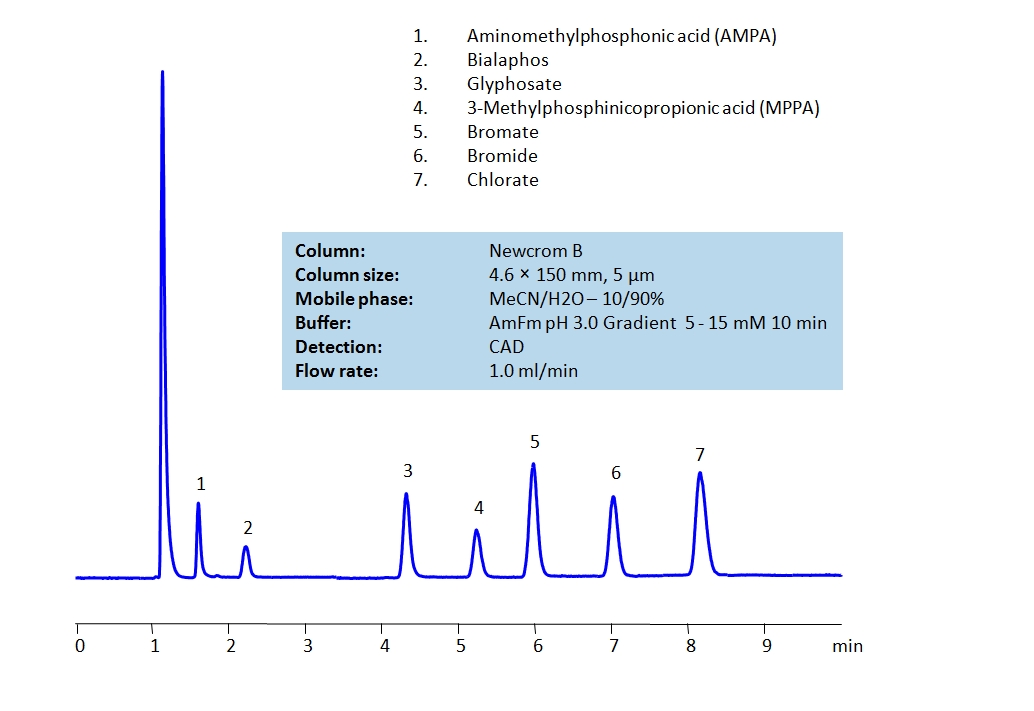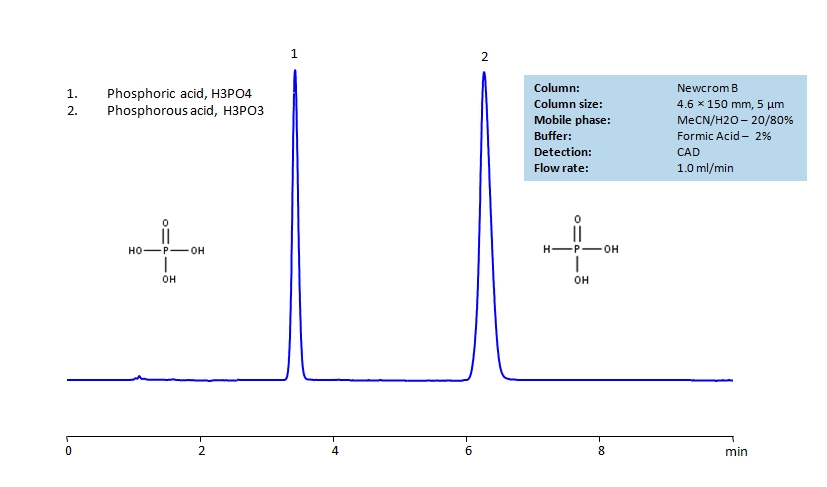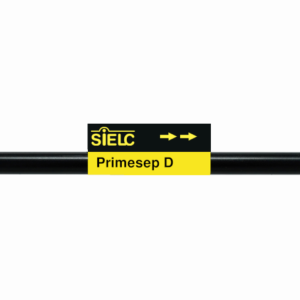| CAS Number | 10294-56-1 |
|---|---|
| Molecular Formula | H3O3P |
| Molecular Weight | 81.995 |
| InChI Key | OJMIONKXNSYLSR-UHFFFAOYSA-N |
| LogP | 1.15 |
| Synonyms |
|
Applications:
HPLC Separation of Polar Pesticides on Newcrom B Column
November 19, 2020
Pesticide is a more generic term that includes herbicides, fungicides and insecticides in its definition. Herbicides are used to control unwanted plants, they are also known as weedkillers. Insecticides are used to kill insects. Fungicides are used to kill parasitic fungi. All are heavily used in agriculture. By using HPLC, many different pesticides can be separated and their retention characteristics controlled using the Newcrom B mixed-mode column.
| Column | Newcrom B, 4.6×150 mm, 5 µm, 100A |
| Mobile Phase | MeCN/H2O – 10/90% |
| Buffer | AmFm pH 3.0 Gradient 5 – 60 mM 15 min |
| Flow Rate | 1 ml/min |
| Detection | CAD |
| Column | Newcrom B, 4.6×150 mm, 5 µm, 100A |
| Mobile Phase | MeCN/H2O – 10/90% |
| Buffer | AmFm pH 3.0 Gradient 5 – 15 mM 10 min |
| Flow Rate | 1 ml/min |
| Detection | CAD |
| Class of Compounds | Pesticides, Herbicides, Fungicides, Insecticides |
| Analyzing Compounds | Aminomethylphosphonic acid (AMPA), Bialaphos, Glyphosate, Phosphorous acid H3PO3, Fosetyl-Al, Bromide, Chlorate, Perchlorate, 3-Methylphosphinicopropionic acid (MPPA), Bromide |
Application Column
Newcrom B
The Newcrom columns are a family of reverse-phase-based columns. Newcrom A, AH, B, and BH are all mixed-mode columns with either positive or negative ion-pairing groups attached to either short (25 Å) or long (100 Å) ligand chains. Newcrom R1 is a special reverse-phase column with low silanol activity.
Select optionsAminomethylphosphonic acid (AMPA)
Bialaphos
Bromate
Bromide
Chlorate
Fosetyl-Al
Glyphosate
Perchlorate
Phosphorous acid
Sodium Bromate

HPLC Separation of Phosphoric and Phosphorous Acids on Newcrom B Column
March 11, 2020
| Column | Newcrom B, 4.6×150 mm, 5 µm, 100A |
| Mobile Phase | MeCN/H2O – 20/80% |
| Buffer | Formic Acid – 2% |
| Flow Rate | 1.0 ml/min |
| Detection | CAD (Corona) MS- compatible mobile phase |
| Class of Compounds | Hydrophilic, Acid |
| Analyzing Compounds | Phosphoric acid, Phosphorous acid |
Application Column
Newcrom B
The Newcrom columns are a family of reverse-phase-based columns. Newcrom A, AH, B, and BH are all mixed-mode columns with either positive or negative ion-pairing groups attached to either short (25 Å) or long (100 Å) ligand chains. Newcrom R1 is a special reverse-phase column with low silanol activity.
Select optionsPhosphorous acid

HPLC Separation of Phosphorous and Phosphoric Acids
July 10, 2012
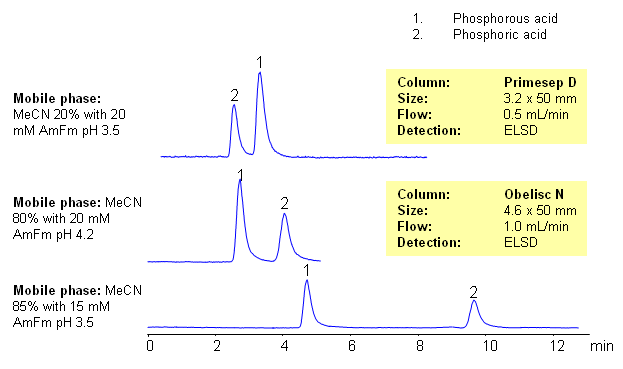
Application Notes: Phosphorus and phosphoric acid were separated on Obelisc N and Primesep D columns. On Obelisc N both acids retained by combination of HILIC and anion-exchange mechanisms. OnPrimesep D these inogranic acids are retained by anion-exchange mechanism. Both columns and methods can be used for analysis of hydrophilic organic and inorganic acids with multi-mode or single mode approach
Application Columns: Primesep D, Obelisc N
Application compounds: Phosphorous Acid, Phosphoric Acid
Detection technique: UV, LC/MS, ELSD/CAD
| Column | Primesep D, 3.2×50 mm, 5 µm, 100A |
| Mobile Phase | MeCN |
| Buffer | AmFm |
| Flow Rate | 0.5 ml/min |
| Detection | ELCD |
| Column | Obelisc N, 4.6×50 mm, 5 µm, 100A |
| Mobile Phase | MeCN |
| Buffer | AmFm |
| Flow Rate | 1.0 ml/min |
| Detection | ELSD |
| Class of Compounds |
Acid, Fungicide, Hydrophilic, Ionizable |
| Analyzing Compounds | Phosphorous Acid, Phosphoric Acids |
Application Column
Obelisc N
SIELC has developed the Obelisc™ columns, which are mixed-mode and utilize Liquid Separation Cell technology (LiSC™). These cost-effective columns are the first of their kind to be commercially available and can replace multiple HPLC columns, including reversed-phase (RP), AQ-type reversed-phase, polar-embedded group RP columns, normal-phase, cation-exchange, anion-exchange, ion-exclusion, and HILIC (Hydrophilic Interaction Liquid Chromatography) columns. By controlling just three orthogonal method parameters - buffer concentration, buffer pH, and organic modifier concentration - users can adjust the column properties with pinpoint precision to separate complex mixtures.
Select optionsPrimesep D
The Primesep family of mixed-mode columns offers a wide variety of stationary phases, boasting unprecedented selectivity in the separation of a broad array of chemical compounds across multiple applications. Corresponding Primesep guard columns, available with all stationary phases, do not require holders. SIELC provides a method development service available to all customers. Inquire about our specially-tailored custom LC-phases for specific separations.
Select optionsPhosphorous acid
UV Detection

